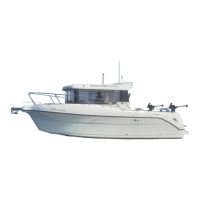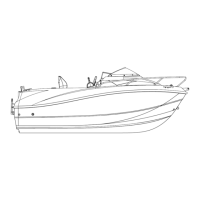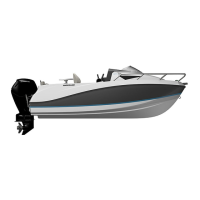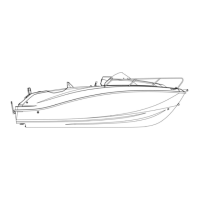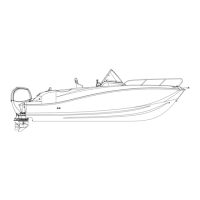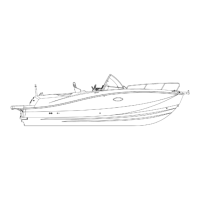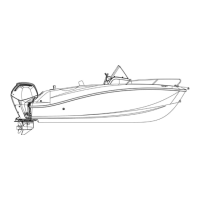Quicksilver 855WE — System & Component Overview and Operaon
20
Fuel Tank
Your boat is equipped with a crosslink polyethylene fuel tank with a capacity of 400 liters. As a
precauon, all of the capacity may not be useable due to trim and loading condions, so consider
keeping at a minimum 25% reserve fuel in the tank.
Fuel tanks with levels less than 25% capacity can cause engine stalling problems due to fuel starvaon
or by allowing sediment and dirt to enter the fuel supply lines. Keep the tank full and monitor the fuel
level oen to prevent this from happening.
Fuel Distribuon
Fuel is delivered from the tank to the engine through the an-siphon valve and the fuel line. The an-
siphon valve is a safety feature designed to prevent fuel from siphoning out of the tank if the fuel line
was ever cut or broken below the level of the fuel in the tank. If the line ever broke, some fuel would
leak out from the line, however, the an-siphon valve prevents the enre contents of the tank to
siphon into the boat.
NEVER REMOVE OR MODIFY THE ANTI-SIPHON VALVE FROM THE FUEL TANK.
Ethanol—Blended Fuels
Ethanol is an oxygenated hydrocarbon compound that has a high octane rang and therefore is useful
in increasing the octane level of unleaded gasoline. The fuel system components of your Mercury
engine(s) have been tested to perform with the maximum level of ethanol blended gasoline (10%
ethanol), currently allowed by the EPA in the United States.
Special precauons should be considered with the use of fuel containing ethanol in your system. Fuels
with ethanol can aack some fuel-system components, such as tanks and lines, if they are not made
from acceptable ethanol-compable materials. This can lead to operaonal problems or safety issues
such as clogged lters, leaks, or engine damage.
Your boat was manufactured, and shipped from the factory with ethanol compable materials. Before
introducing petrol with ethanol into your fuel tank, ask your dealer if any components have been
added or replaced that are not recommended by Quicksilver®, Mercury or may not be ethanol-
compable.
Filling The Tank
It is best to maintain a full tank of fuel when the engine is not in use. This will reduce the air ow in
and out of the tank due to changes in temperature as well as liming exposure of ethanol in the fuel
to humidity and condensaon.
When lling the tank, do not aempt to top o the tank. When the nozzle shuts o, the tank is full,
and connuing to ll past the fuel ll shuto will cause the system to spit fuel back.
Do not store any equipment containing petrol (outboard
engines, portable petrol tanks, etc.) in any cockpit storage
areas. These compartments were not designed to store
petrol and do not have adequate venlaon.
Petrol vapors can explode. Never smoke while handling or
lling up the petrol tank. Leaking fuel is a re and explosion
hazard. Inspect the fuel system annually to make sure that
there are no leaks and corrosion in the system.
